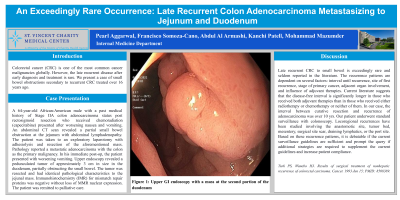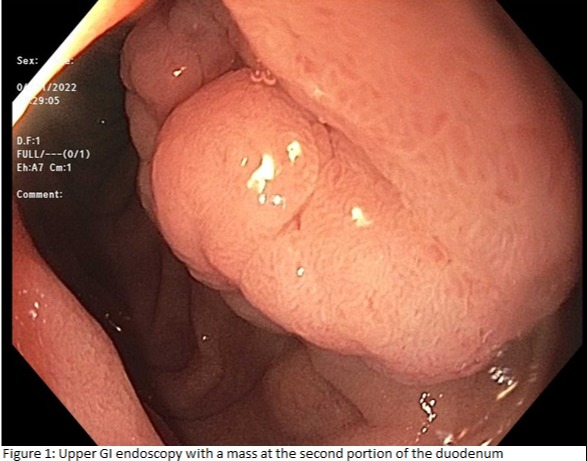Back


Poster Session B - Monday Morning
Category: Colorectal Cancer Prevention
B0181 - An Exceedingly Rare Occurrence: Late Recurrent Colon Adenocarcinoma Metastasizing to Jejunum and Duodenum
Monday, October 24, 2022
10:00 AM – 12:00 PM ET
Location: Crown Ballroom

Has Audio

Pearl Aggarwal, MD
St. Vincent Charity Medical Center
Cleveland, OH
Presenting Author(s)
Pearl Aggarwal, MD1, Francisco Somoza-Cano, MD1, Kanchi Patell, MD1, Abdul Rahman Al Armashi, MD2, Mohammed K. Mazumder, MD1
1St. Vincent Charity Medical Center, Cleveland, OH; 2University Hospitals Case Western Reserve University, Cleveland, OH
Introduction: Colorectal cancer (CRC) is one of the most common cancer malignancies globally. However, the late recurrent disease after early diagnosis and treatment is rare. We present a case of small bowel obstructions secondary to recurrent CRC treated over 16 years ago.
Case Description/Methods: A 64-year-old African-American male with a past medical history of Stage IIA colon adenocarcinoma status post rectosigmoid resection who received chemoradiation (capecitabine) presented after worsening nausea and vomiting. An abdominal CT scan revealed a partial small bowel obstruction at the jejunum with abdominal lymphadenopathy. The patient was taken to an exploratory laparotomy with adhesiolysis and resection of the aforementioned mass. Pathology reported a metastatic adenocarcinoma with the colon as the primary malignancy. In his immediate post-op, the patient presented with worsening vomiting. Upper endoscopy revealed a pedunculated tumor of approximately 3 cm in size in the duodenum, partially obstructing the small bowel. The tumor was resected and had identical pathological characteristics to the jejunal mass. Immunohistochemistry (IMR) for mismatch repair proteins was negative without loss of MMR nuclear expression. The patient was remitted to palliative care.
Discussion: Late recurrent CRC to small bowel is exceedingly rare and seldom reported in the literature. The recurrence patterns are dependent on several factors: interval until recurrence, site of first recurrence, stage of primary cancer, adjacent organ involvement, and influence of adjuvant therapies. Current literature suggests that the disease-free interval is significantly longer in those who received both adjuvant therapies than in those who received either radiotherapy or chemotherapy or neither of them. In our case, the interval between curative resection and recurrence of adenocarcinoma was over 10 yrs. Our patient underwent standard surveillance with colonoscopy. Locoregional recurrences have been studied involving the anastomotic site, tumor bed, mesentery, surgical site scar, draining lymphatics, or the port site. Based on these recurrence patterns, it is debatable if the current surveillance guidelines are sufficient and prompt the query if additional strategies are required to supplement the current guidelines and increase patient compliance.
Reference
Turk PS, Wanebo HJ. Results of surgical treatment of nonhepatic recurrence of colorectal carcinoma. Cancer. 1993 Jun 15; PMID: 8508389.

Disclosures:
Pearl Aggarwal, MD1, Francisco Somoza-Cano, MD1, Kanchi Patell, MD1, Abdul Rahman Al Armashi, MD2, Mohammed K. Mazumder, MD1. B0181 - An Exceedingly Rare Occurrence: Late Recurrent Colon Adenocarcinoma Metastasizing to Jejunum and Duodenum, ACG 2022 Annual Scientific Meeting Abstracts. Charlotte, NC: American College of Gastroenterology.
1St. Vincent Charity Medical Center, Cleveland, OH; 2University Hospitals Case Western Reserve University, Cleveland, OH
Introduction: Colorectal cancer (CRC) is one of the most common cancer malignancies globally. However, the late recurrent disease after early diagnosis and treatment is rare. We present a case of small bowel obstructions secondary to recurrent CRC treated over 16 years ago.
Case Description/Methods: A 64-year-old African-American male with a past medical history of Stage IIA colon adenocarcinoma status post rectosigmoid resection who received chemoradiation (capecitabine) presented after worsening nausea and vomiting. An abdominal CT scan revealed a partial small bowel obstruction at the jejunum with abdominal lymphadenopathy. The patient was taken to an exploratory laparotomy with adhesiolysis and resection of the aforementioned mass. Pathology reported a metastatic adenocarcinoma with the colon as the primary malignancy. In his immediate post-op, the patient presented with worsening vomiting. Upper endoscopy revealed a pedunculated tumor of approximately 3 cm in size in the duodenum, partially obstructing the small bowel. The tumor was resected and had identical pathological characteristics to the jejunal mass. Immunohistochemistry (IMR) for mismatch repair proteins was negative without loss of MMR nuclear expression. The patient was remitted to palliative care.
Discussion: Late recurrent CRC to small bowel is exceedingly rare and seldom reported in the literature. The recurrence patterns are dependent on several factors: interval until recurrence, site of first recurrence, stage of primary cancer, adjacent organ involvement, and influence of adjuvant therapies. Current literature suggests that the disease-free interval is significantly longer in those who received both adjuvant therapies than in those who received either radiotherapy or chemotherapy or neither of them. In our case, the interval between curative resection and recurrence of adenocarcinoma was over 10 yrs. Our patient underwent standard surveillance with colonoscopy. Locoregional recurrences have been studied involving the anastomotic site, tumor bed, mesentery, surgical site scar, draining lymphatics, or the port site. Based on these recurrence patterns, it is debatable if the current surveillance guidelines are sufficient and prompt the query if additional strategies are required to supplement the current guidelines and increase patient compliance.
Reference
Turk PS, Wanebo HJ. Results of surgical treatment of nonhepatic recurrence of colorectal carcinoma. Cancer. 1993 Jun 15; PMID: 8508389.

Figure: Upper GI endoscopy with a mass at the second portion of the duodenum
Disclosures:
Pearl Aggarwal indicated no relevant financial relationships.
Francisco Somoza-Cano indicated no relevant financial relationships.
Kanchi Patell indicated no relevant financial relationships.
Abdul Rahman Al Armashi indicated no relevant financial relationships.
Mohammed Mazumder indicated no relevant financial relationships.
Pearl Aggarwal, MD1, Francisco Somoza-Cano, MD1, Kanchi Patell, MD1, Abdul Rahman Al Armashi, MD2, Mohammed K. Mazumder, MD1. B0181 - An Exceedingly Rare Occurrence: Late Recurrent Colon Adenocarcinoma Metastasizing to Jejunum and Duodenum, ACG 2022 Annual Scientific Meeting Abstracts. Charlotte, NC: American College of Gastroenterology.
